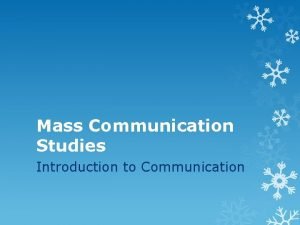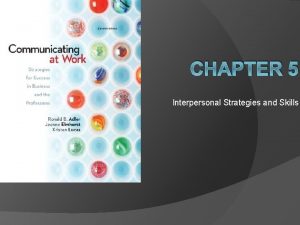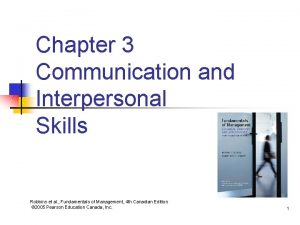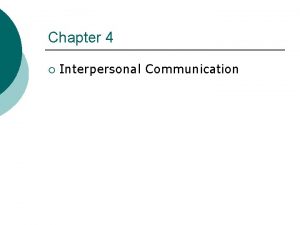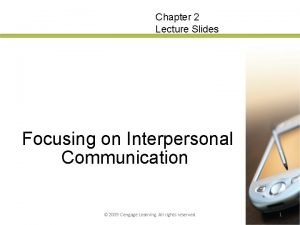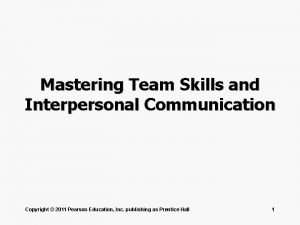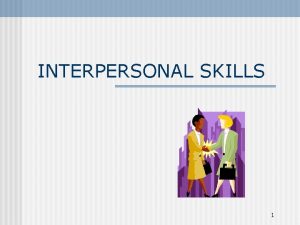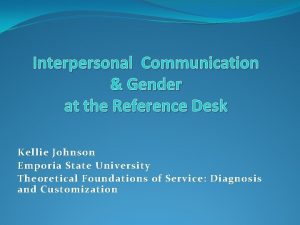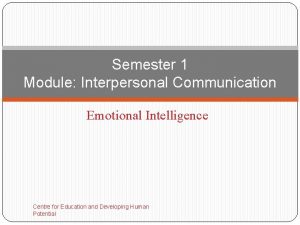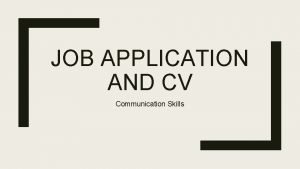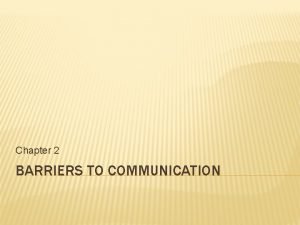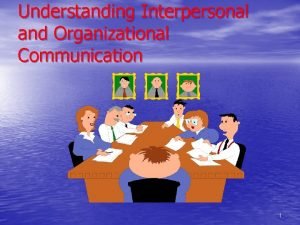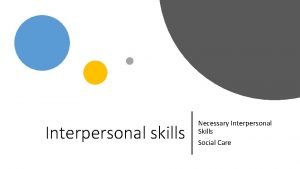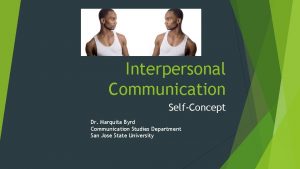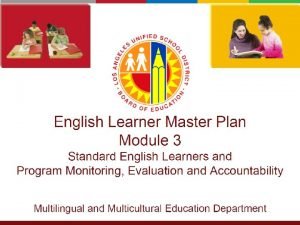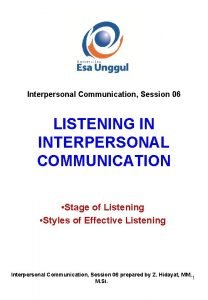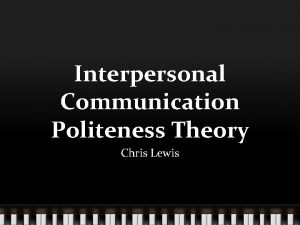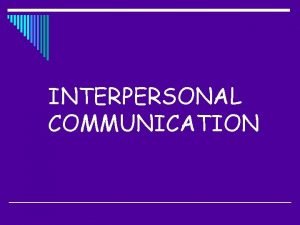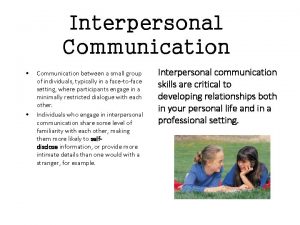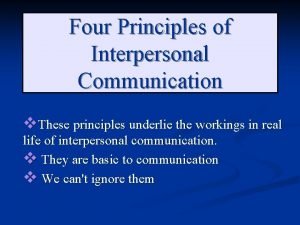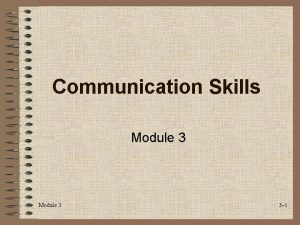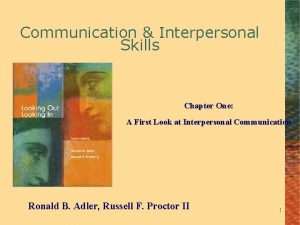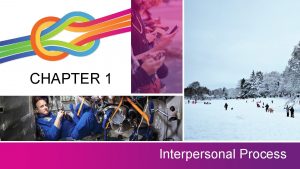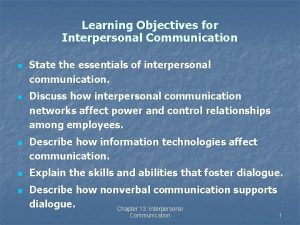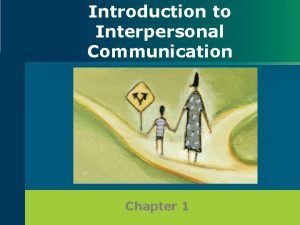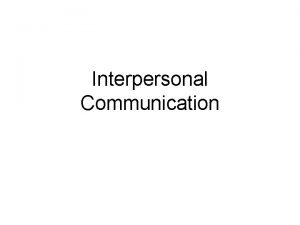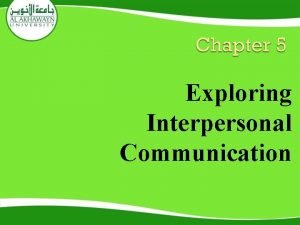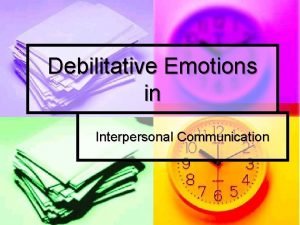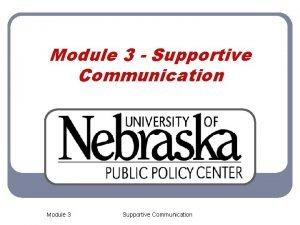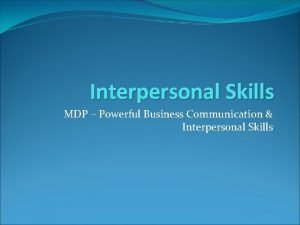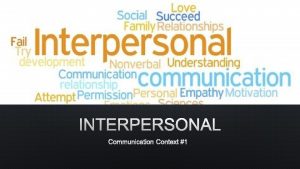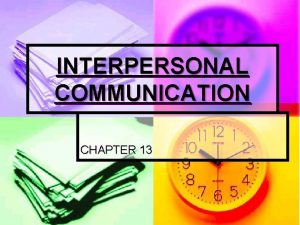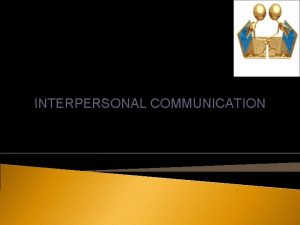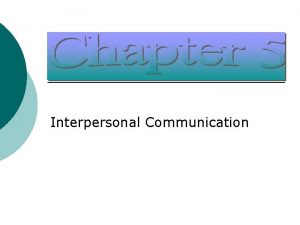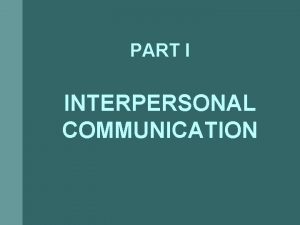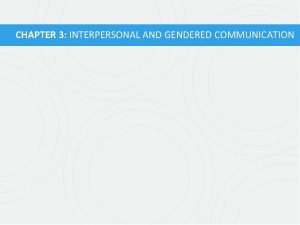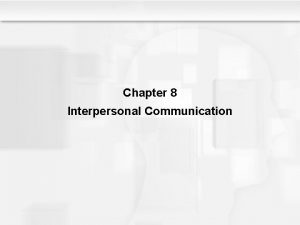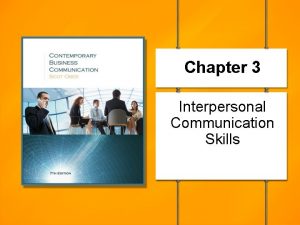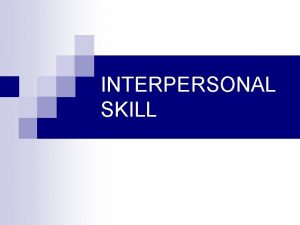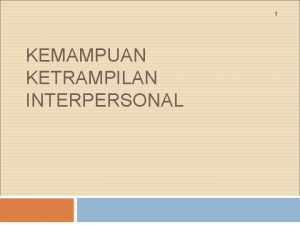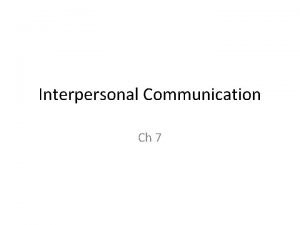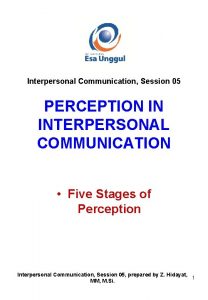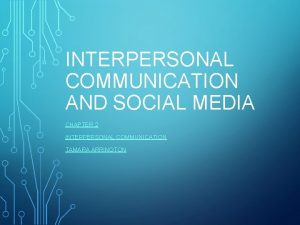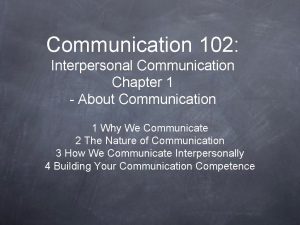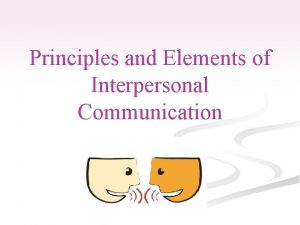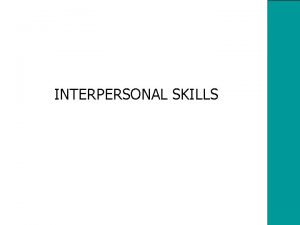Part 4 Leading Chapter 12 Communication and Interpersonal



































- Slides: 35

Part 4: Leading Chapter 12 Communication and Interpersonal Skills Power. Point Presentation by Charlie Cook Copyright © 2004 Prentice Hall, Inc. All rights reserved.

LEARNING OUTCOMES After reading this chapter, I will be able to: 1. Define communication and explain why it is important to managers. 2. Describe the communication process. 3. List techniques for overcoming communication barriers. 4. Describe the wired and wireless technologies affecting organizational communications. 5. Identify behaviors related to effective active listening. Copyright © 2004 Prentice Hall, Inc. All rights reserved. 2

L E A R N I N G O U T C O M E S (cont’d) After reading this chapter, I will be able to: 6. Explain what behaviors are necessary for providing effective feedback. 7. Identify behaviors related to effective delegating. 8. Describe the steps in analyzing and resolving conflict. 9. Explain why a manager might stimulate conflict. 10. Contrast distributive and integrative bargaining. Copyright © 2004 Prentice Hall, Inc. All rights reserved. 3

The Communication Process • Communication process Ø The transferring and understanding of meaning EXHIBIT 12. 1 Copyright © 2004 Prentice Hall, Inc. All rights reserved. 4

Communication Process Terms • Encoding Ø The conversion of a message into some symbolic form • Message Ø A purpose to be conveyed • Channel Ø The medium by which a message travels • Feedback Ø The degree to which carrying out the work activities require by a job results in the individual’s obtaining direct and clear information about the effectiveness of his her performance • Decoding Ø A receiver’s translation of a sender’s message Copyright © 2004 Prentice Hall, Inc. All rights reserved. 5

Written Versus Verbal Communications • Written Ø Tangible Ø Verifiable Ø More permanent Ø More precise Ø More care is taken with the written word Copyright © 2004 Prentice Hall, Inc. All rights reserved. • Verbal Ø Less secure Ø Known receipt Ø Quicker response Ø Consumes less time Ø Quicker feedback 6

The Grapevine “The grapevine motto: Good information passes among people fairly rapidly—bad information, even faster!” • Grapevine Ø An unofficial channel of communication that is neither authorized nor supported by the organization. Copyright © 2004 Prentice Hall, Inc. All rights reserved. 7

Nonverbal Communications • Body language Ø Nonverbal communication cues such as facial expressions, gestures, and other body movements • Verbal intonation Ø An emphasis given to word or phrases that conveys meaning Copyright © 2004 Prentice Hall, Inc. All rights reserved. 8

Using Simple Language? Source: Dilbert reprinted by permission of United Features Syndicate, Inc. Copyright © 2004 Prentice Hall, Inc. All rights reserved. EXHIBIT 12. 4 9

Barriers to Effective Communication Overcoming Barriers to Effective Communication • Filtering • Selective Perception • Information Overload • Emotions • Language • Gender • National Culture • Use Feedback • Simplify Language • Listen actively • Constrain Emotions • Watch Nonverbal Cues EXHIBIT 12. 2 Copyright © 2004 Prentice Hall, Inc. All rights reserved. EXHIBIT 12. 3 10

Communication Barriers • Filtering Ø The deliberate manipulation of information to make it appear more favorable to the receiver • Selective perception Ø Selective hearing communications based on one’s needs, motivations, experience, or other personal characteristics • Information overload Ø The result of information exceeding processing capacity Copyright © 2004 Prentice Hall, Inc. All rights reserved. 11

Communication Barriers (cont’d) • Jargon Ø Technical language that is not understood by outsiders • Gender Ø Men communicate to emphasize status and independence; whereas women talk to create connections and intimacy. • National culture Ø Communication differences that arise from the different languages and national cultures Copyright © 2004 Prentice Hall, Inc. All rights reserved. 12

Information Technology (IT) • E-mail Ø The instantaneous transmission of messages on computers that are linked together. • Instant messaging (IM) Ø Interactive, real-time communication that takes place among computer users who are logged on to the computer network at the same time. • Voice mail Ø A system digitizes that a spoken massage, transmits it over the network, and stores the message on a disk for the receiver to retrieve later. Copyright © 2004 Prentice Hall, Inc. All rights reserved. 13

Information Technology (cont’d) • Fax Ø Machines allow the transmission of documents containing both text and graphics over ordinary telephone lines. • Electronic data interchange EDI Ø A way to exchange documents (invoices or purchase orders) with vendors, suppliers, and customers using direct, computer-to-computer networks. • Teleconferencing Ø Group can confer simultaneously using telephone or e -mail group communications software. Copyright © 2004 Prentice Hall, Inc. All rights reserved. 14

Information Technology (cont’d) • Teleconferencing Ø Group can confer simultaneously using telephone or e -mail group communications software. • Video-conferencing Ø A simultaneous conference during which meeting participants in different locations can see each other over video screens. Copyright © 2004 Prentice Hall, Inc. All rights reserved. 15

Information Technology (cont’d) • Intranets Ø An organizational communication network that uses Internet technology but is accessible only to organizational employees. • Extranets Ø an organizational communication network that uses Internet technology and allows authorized users inside the organization to communicate with certain outsiders such as customers or vendors. Copyright © 2004 Prentice Hall, Inc. All rights reserved. 16

Information Technology (cont’d) • Wireless communications Ø Allow users to send and receive information from anywhere as signals sent without a direct physical connection to a hard-wired network system. • Knowledge management Ø Cultivating a learning culture in which employees systematically gather knowledge and share it through computer-based networks and community of interest teams. Copyright © 2004 Prentice Hall, Inc. All rights reserved. 17

Developing Interpersonal Skills • Listening requires: Ø Paying attention Ø Interpreting Ø Remembering sound stimuli • Active listening requires: Ø Listening attentively (intensely) to the speaker. Ø Developing empathy for what the speaker is saying. Ø Accepting by listening without judging content. Ø Taking responsibility for completeness in getting the full meaning from the speaker’s communication. Copyright © 2004 Prentice Hall, Inc. All rights reserved. 18

Characteristics of Feedback • Positive feedback Ø Is more readily and accurately perceived than negative feedback. Ø Is almost always accepted, whereas negative feedback often meets resistance. • Negative feedback Ø Is most likely to be accepted when it comes from a credible source or if it is objective. Ø Carries weight only when it comes from a person with high status and credibility. Copyright © 2004 Prentice Hall, Inc. All rights reserved. 19

Suggestions for Effective Feedback • Focus on specific behavior • Keep feedback impersonal • Keep feedback goal oriented • Make feedback well-timed • Ensure understanding • Direct negative feedback towards behavior that the receiver can control EXHIBIT 12. 5 Copyright © 2004 Prentice Hall, Inc. All rights reserved. 20

Empowerment Skills • Delegation Ø The assignment of authority to another person to carry out specific activities while retaining the ultimate responsibility for the activities. • Proper delegation is not abdication and requires: Ø Clarifying the exact job to be done Ø Setting the range of the employee’s discretion Ø Defining the expected level of performance Ø Setting the time frame for the task to be completed Ø Allowing employees to participate Ø Establishing feedback controls Copyright © 2004 Prentice Hall, Inc. All rights reserved. 21

Effective Delegation EXHIBIT 12. 6 Copyright © 2004 Prentice Hall, Inc. All rights reserved. 22

Contingency Factors in Delegation The Size of the Organization The Importance of the Duty or Decision Organizational Culture Task Complexity Qualities of Employees EXHIBIT 12. 7 Copyright © 2004 Prentice Hall, Inc. All rights reserved. 23

Managing Conflict • Conflict defined Ø Perceived differences resulting in interference or opposition • Functional conflict Ø Conflict that supports and organization’s goals • Dysfunctional conflict Ø Conflict that prevents and organization from achieving its goals Copyright © 2004 Prentice Hall, Inc. All rights reserved. 24

Three Views of Conflict • Traditional view Ø Assumed that conflict was bad and would always have a negative impact on an organization. • Human relations view Ø Argued that conflict was a natural and inevitable occurrence in all organizations; rationalized the existence of conflict and advocated its acceptance. • Interactionist view Ø Encourages mangers to maintain ongoing minimum level of conflict sufficient to keep organizational units viable, self-critical, and creative. EXHIBIT 12. 8 Copyright © 2004 Prentice Hall, Inc. All rights reserved. 25

Conflict and Organizational Performance EXHIBIT 12. 9 Copyright © 2004 Prentice Hall, Inc. All rights reserved. 26

Sources of Conflict • Communication differences Ø Arising from semantic difficulties, misunderstandings, and noise in the communication channels. • Structural differences Ø Horizontal and vertical differentiation creates problems of integration leading to disagreements over goals, decision alternatives, performance criteria, and resource allocations in organizations. • Personal differences Ø Individual idiosyncrasies and personal value systems create conflicts. Copyright © 2004 Prentice Hall, Inc. All rights reserved. 27

Dimensions of Conflict (Thomas) • Cooperativeness Ø The degree to which an individual will attempt to rectify a conflict by satisfying the other person’s concerns. • Assertiveness Ø The degree to which an individual will attempt to rectify the conflict to satisfy his or her own concerns. Copyright © 2004 Prentice Hall, Inc. All rights reserved. 28

Dimensions of Conflict (cont’d) • Conflict-handling techniques derived from Thomas’ cooperative and assertiveness dimensions: Ø Competing (assertive but uncooperative) Ø Collaborating (assertive and cooperative) Ø Avoiding (unassertive and uncooperative) Ø Accommodating (unassertive but cooperative) Ø Compromising (midrange on assertiveness and cooperativeness Copyright © 2004 Prentice Hall, Inc. All rights reserved. 29

Conflict Management What Works Best and When Strategy Best Used When Avoidance Conflict is trivial, when emotions are running high and time is needed to cool them down, or when the potential disruption from an assertive action outweighs the benefits of resolution Accommodation The issue under dispute isn’t that important to you or when you want to build up credits for later issues Forcing You need a quick resolution on important issues that require unpopular actions to be taken and when commitment by others to your solution is not critical Compromise Conflicting parties are about equal in power, when it is desirable to achieve a temporary solution to a complex issue, or when time pressures demand an expedient solution Collaboration Time pressures are minimal, when all parties seriously want a win-win solution, and when the issue is too important to be compromised EXHIBIT 12. 10 Copyright © 2004 Prentice Hall, Inc. All rights reserved. 30

Stimulating Conflict • Convey to employees the message that conflict has its legitimate place. • Use hot-button communications while maintaining plausible deniability. • Issue ambiguous or threatening messages. • Centralize decisions, realign work groups, increase formalization and interdependencies between units. • Appoint a devil’s advocate to purposely present arguments that run counter to those proposed by the majority or against current practices. Copyright © 2004 Prentice Hall, Inc. All rights reserved. 31

Negotiation • Negotiation defined Ø A process in which two or more parties who have different preference must make a joint decision and come to an agreement • Distributive bargaining Ø Negotiation under zero-sum conditions, in which the gains by one party involve losses by the other party • Integrative bargaining Ø Negotiation in which there is at least one settlement that involves no loss to either party Copyright © 2004 Prentice Hall, Inc. All rights reserved. 32

Determining the Bargaining Zone EXHIBIT 12. 11 Copyright © 2004 Prentice Hall, Inc. All rights reserved. 33

Developing Effective Negotiation Skills • Research the individual with whom you’ll be negotiating. • Begin with a positive overture. • Address problems, not personalities. • Pay little attention to initial offers. • Emphasize win-win solutions. • Create an open and trusting climate. • If needed, be open to accepting third-party assistance. Copyright © 2004 Prentice Hall, Inc. All rights reserved. 34

How Do You Make a Presentation? • Prepare for the presentation. • Make your opening comments. • Make your points. • End the presentation. • Answer questions. Copyright © 2004 Prentice Hall, Inc. All rights reserved. 35
 Bobbin leading and flyer leading
Bobbin leading and flyer leading Examples of mass communication
Examples of mass communication Chapter 6 interpersonal communication
Chapter 6 interpersonal communication Chapter 5 interpersonal communication
Chapter 5 interpersonal communication Chapter 3 interpersonal communication
Chapter 3 interpersonal communication Noise in interpersonal communication
Noise in interpersonal communication Chapter 12 interpersonal communication
Chapter 12 interpersonal communication Define the relationship ch 6
Define the relationship ch 6 Chapter 8 interpersonal communication
Chapter 8 interpersonal communication Interpersonal communication chapter 2
Interpersonal communication chapter 2 Intrapersonal and interpersonal difference
Intrapersonal and interpersonal difference Mastering team skills and interpersonal communication
Mastering team skills and interpersonal communication Pengertian interpersonal skill
Pengertian interpersonal skill Gender interpersonal communication
Gender interpersonal communication Interpersonal communication and emotional intelligence
Interpersonal communication and emotional intelligence Special skills for a job application
Special skills for a job application Too many transfer stations and fear of superiors act as a
Too many transfer stations and fear of superiors act as a Interpersonal and organizational communication
Interpersonal and organizational communication Interpersonal skills social work
Interpersonal skills social work Marquita byrd
Marquita byrd Basic interpersonal communication skills
Basic interpersonal communication skills Listening styles interpersonal communication
Listening styles interpersonal communication Preventative facework
Preventative facework Communication is inescapable
Communication is inescapable Interpersonal situations
Interpersonal situations Osmo wiio laws of communication
Osmo wiio laws of communication Module 3 communication/interpersonal skills
Module 3 communication/interpersonal skills Qualitatively interpersonal communication
Qualitatively interpersonal communication More communication is always better
More communication is always better Objectives of interpersonal communication
Objectives of interpersonal communication Ethics in interpersonal communication
Ethics in interpersonal communication Barriers to interpersonal skills
Barriers to interpersonal skills Exploring interpersonal communication
Exploring interpersonal communication Facilitative emotions examples
Facilitative emotions examples Supportive verbal communication
Supportive verbal communication Interpersonal skills in business communication
Interpersonal skills in business communication

